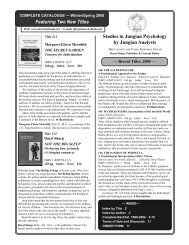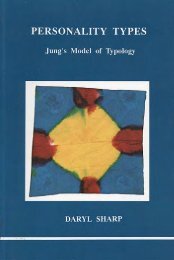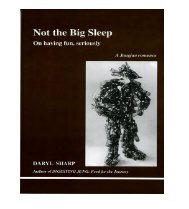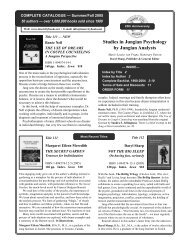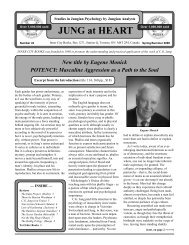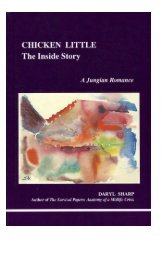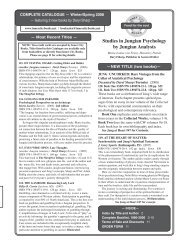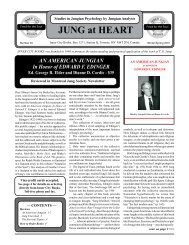Digesting Jung: Food for the Journey - Inner City Books
Digesting Jung: Food for the Journey - Inner City Books
Digesting Jung: Food for the Journey - Inner City Books
You also want an ePaper? Increase the reach of your titles
YUMPU automatically turns print PDFs into web optimized ePapers that Google loves.
11<br />
True and False Brides/Bridegrooms<br />
The truth of yesterday must be set aside <strong>for</strong> what is now<br />
<strong>the</strong> truth of one’s psychic life. 32<br />
A dominant but inappropriate anima-image in a man’s psyche is<br />
characterized in fairy tales as a false bride. It is <strong>the</strong> hero’s task to<br />
find <strong>the</strong> true one. The essential difference between <strong>the</strong> two, psychologically,<br />
is captured in <strong>the</strong> above observation.<br />
True and false brides don’t come labeled. Much depends on a<br />
man’s age, his position in life and how much work he has done on<br />
himself—particularly <strong>the</strong> extent to which he has differentiated his<br />
soul-image from <strong>the</strong> o<strong>the</strong>r complexes teeming in his psyche.<br />
Theoretically <strong>the</strong>re are two basic types of false bride. One is an<br />
anima figure—or an actual woman—who leads a man into <strong>the</strong> fantasy<br />
realm, away from timely responsibilities in <strong>the</strong> outside world.<br />
The o<strong>the</strong>r is an inner voice—or again a real woman—that would tie<br />
a man to his persona when his real task is to turn inward, to find<br />
himself behind <strong>the</strong> face he shows o<strong>the</strong>rs.<br />
The first type is commonly associated with <strong>the</strong> attitudes of a<br />
younger man: idealism, <strong>the</strong> disinclination to compromise, a rigid<br />
response to <strong>the</strong> reality of everyday life. The second type of false<br />
bride is associated with regressive tendencies in later life, such as<br />
feverish ef<strong>for</strong>ts to mask one’s age or reclaim a lost youth through<br />
younger companions, face lifts, hair transplants and so on.<br />
There is no hard and fast rule, however. An older man with too<br />
much unlived life may have to descend into <strong>the</strong> whore’s cellar, so<br />
to speak, as part of his individuation process. The younger man<br />
with no ideals may be obliged to develop some.<br />
As happens with any psychological content, <strong>the</strong> bride of ei<strong>the</strong>r<br />
32 Marie-Louise von Franz, Redemption Motifs in Fairy Tales, p. 85.<br />
49



